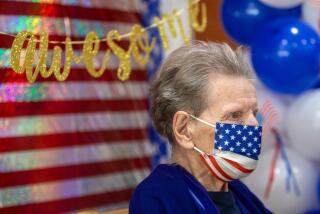Lynn Sherr examines the public and private lives of Sally Ride
- Share via
That Sally Ride would become America’s first woman in space in 1983 seems both unlikely and inevitable when reading Lynn Sherr’s new biography, “Sally Ride” (Simon & Schuster, 400pp., $28). Unlikely because Ride was a sporty Southern California girl with an imperfect GPA who left her undergraduate program to try to become a tennis pro; inevitable because her intellectual gifts, intense focus and genuine likability made her a singular candidate for anything, astronaut included.
Sherr was covering the space program for ABC News when she met Ride, one of 35 astronauts — and six women — hoping to go up in the Space Shuttle. They became close friends; after the Challenger exploded in 1986, the night before the official memorial, the women and their husbands had dinner together.
It wasn’t until Ride died of pancreatic cancer in 2012 that Sherr (and most people who knew the astronaut) learned that she had spent the last 27 years of her life with a female partner, Tam O’Shaughnessy.
Yet the same-sex relationship “was clearly a very, very important part of Sally’s life. There was no way I was not going to write about it,” Sherr says by phone from New York. “There was no way it was going to get scrunched into one tiny little mention at the bottom. So I chose to weave it through the book pretty much chronologically.”
With the cooperation of family and friends and access to Ride’s diaries, Sherr draws a full picture of her as a young woman: friendly, sometimes carefree, other times driven to succeed.
Born and raised in the San Fernando Valley, Ride attended the elite Westlake school on a tennis scholarship. She went to Swarthmore but left after three semesters to try her luck as a professional tennis player. One thing kept her from succeeding, she later joked: her forehand.
Sherr says that Ride “never dwelled on the failures or the mistakes or missed opportunities. She pivoted and moved on to the next step.”
That was Stanford, where she was the school’s #1 singles player and, for a time, its only female physics major. She double majored in physics and English, then entered Stanford’s PhD program studying astrophysics.
It was in her last days as a PhD student that Ride read a story in the Stanford student newspaper: “NASA to Recruit Women.” That’s part of her lore as an astronaut. But her relationship with fellow student Molly Tyson is not, and Sherr gets the story from Tyson herself, who remembers her warmly — as do the rest of Ride’s exes, including physicist Bill Colson and astronaut Steve Hawley.
Once she entered the space program, Ride was intent upon succeeding inside NASA. Sherr, who says it was exciting to remember those days at the space program, describes the astronaut training and science of the Shuttle with flair.
Ride’s selection to be the first American woman in space was met with a tsunami of media attention. She gave countless interviews, entertained some silly questions — would she be able to have children after her space flight? — while blasting through the astronaut glass ceiling.
In 1986 she was still a part of NASA, waiting for her next turn in space, when the space shuttle Challenger exploded 73 seconds after launch. The tragedy meant big changes for Ride: She was the only serving astronaut appointed to the investigation committee, her marriage to fellow astronaut Hawley started to come apart, and she secretly began her relationship with O’Shaughnessy.
“I think the Challenger explosion was as much of a reason for her to leave NASA as her decision that she wanted to have a private life,” Sherr says. But to have the personal life she wanted, Ride had to forge a career outside of NASA.
After turning to academia and continuing to publish professional physics papers, Ride founded Sally Ride Science, a program targeted toward young girls. Its many projects — science fairs, children’s books, and even a moon cam — reached thousands of young people.
“She took advantage of the ever-widening definition of ‘woman’s place,’ and spent much of her life making sure it was everywhere,” Sherr writes. “That she could not, or would not, openly identify herself as a gay woman, reflects not only her intense need for privacy but the shame and fear that an intolerant society can inflect even on its heroes.”
More to Read
Sign up for our Book Club newsletter
Get the latest news, events and more from the Los Angeles Times Book Club, and help us get L.A. reading and talking.
You may occasionally receive promotional content from the Los Angeles Times.










